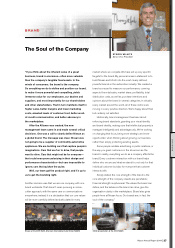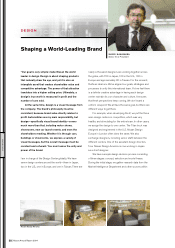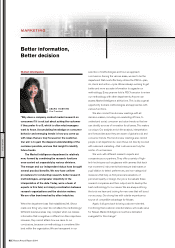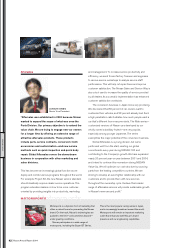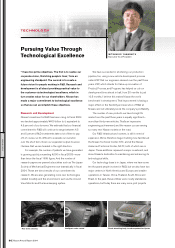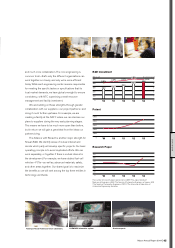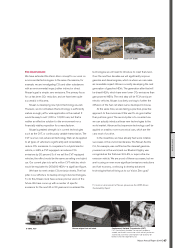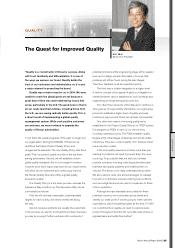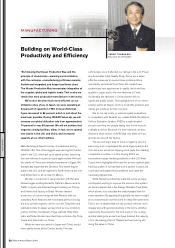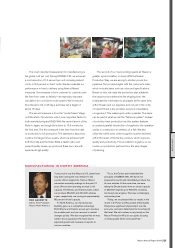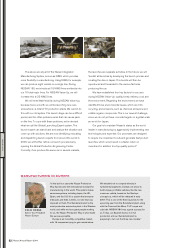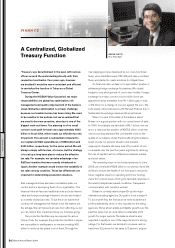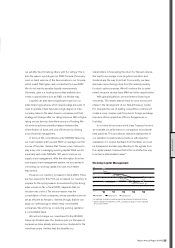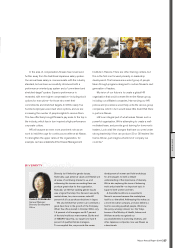Nissan 2005 Annual Report Download - page 49
Download and view the complete annual report
Please find page 49 of the 2005 Nissan annual report below. You can navigate through the pages in the report by either clicking on the pages listed below, or by using the keyword search tool below to find specific information within the annual report.
Nissan Annual Report 2004 47
OUR WORK
X-TRAIL FCV
Sentra CA (USA)Altima Hybrid
Nissan-original fuel cell stack Continuously Variable Transmission (CVT)
CVT (Continuously Variable Transmission) enables a
smooth, continuous transmission which not only enhances
acceleration, but which also improves fuel economy for
better environmental performance
The Environment
We have extended the Vision Zero concept to our work on
environmental technologies. In the area of emissions, for
example, we are investigating CO2and other substances
with an environmental impact, either indirect or direct.
Nissan’s goal is simple: zero emissions. The primary focus
for us has been CO2reduction, and we have been quite
successful in this area.
Nissan is developing new hybrid technology as well.
However, we do not believe this technology is sufficiently
mature enough yet for wide application in the market. It
would be easy to sell 1,000 or 10,000 cars, but that is
neither an effective solution for the environment nor a
financially viable proposition for a manufacturer.
Nissan’s greatest strength is in current technologies
such as the CVT, or continuously variable transmission. The
CVT is a low-cost, advanced technology that can be applied
to all types of vehicles to significantly and immediately
reduce CO2emissions. In comparison to a hybrid electric
vehicle, or HEV, a CVT-equipped car reduces CO2
emissions by 20 percent. So if we sell five CVT-equipped
vehicles, the effect would be the same as selling one hybrid
car. Our current plan is to sell a million CVT vehicles, which
would be equivalent to 200,000 HEVs—a significant figure.
We have to meet certain CO2emission levels. The first
pillar in our efforts is to develop strong future technologies.
To do this, Nissan must have a clear, precise vision of the
future. We have come up with a number of specific
scenarios for the next 40 or 50 years and considered the
technologies we will need to introduce to meet that vision.
Over the next two decades we will significantly improve
gasoline and diesel engines, which is where we can make
an immediate impact. We are currently developing the next
generation of gasoline HEVs. The generation after that will
be diesel HEVs, which have even lower CO2emissions than
gas-powered HEVs. The next step will be FCVs and pure
electric vehicles. Nissan is actively working to further the
diffusion of the fuel-cell stack we’ve developed in-house.
At the same time, we are taking a practical, proactive
approach to the environment. We want to do good rather
than just look good. The second pillar is to consider how
we can actually introduce these new technologies to the
world market. Advanced but expensive technology can’t be
applied on smaller, more economical cars, which are the
cars most of us drive.
In the meantime, we have already had some notable
successes in the environmental area. The Nissan Sentra
CA, for example, was certified as the cleanest gasoline-
powered car in the world, and our Bluebird Sylphy was
recognized as the first-ever SU-LEV, or super-ultra-low
emission vehicle. We are proud of these successes, but we
are focusing on even more significant emissions reductions
and fuel economy, continuing to develop advanced
technologies that will bring us to our Vision Zero goal.”
For more on environment at Nissan, please see the 2005 Nissan
Sustainability Report


